Construction Site Mental Health: Improving Job Satisfaction Rates
VerifiedAdded on 2023/06/08
|10
|3567
|176
Report
AI Summary
This report examines the critical issue of mental health among construction workers and its direct impact on job satisfaction. It highlights the unique challenges faced by workers in this industry, including high-stress environments, tight deadlines, safety concerns, and potential exposure to hazardous materials. The report delves into factors contributing to mental health issues, such as work-life imbalance, job insecurity, bullying, discrimination, and the stigma surrounding mental health. It further suggests potential solutions, emphasizing the importance of risk assessment, providing adequate welfare facilities, promoting health-related activities, and fostering supportive work environments. The report also underscores the need for addressing mental health issues to prevent physical health risks and improve overall wellbeing and job satisfaction among construction workers. Desklib offers a platform to access this and similar solved assignments for students' reference.
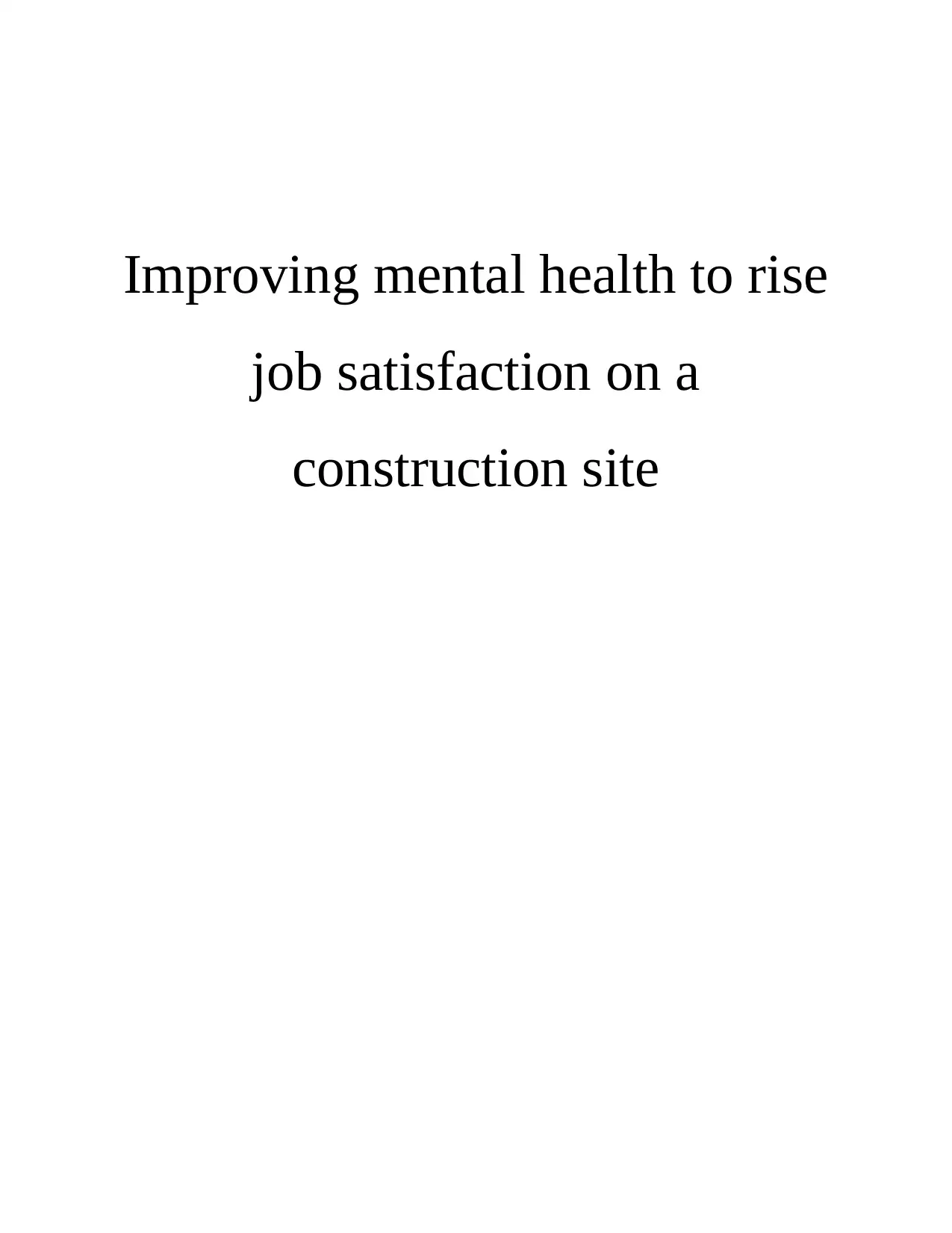
Improving mental health to rise
job satisfaction on a
construction site
job satisfaction on a
construction site
Paraphrase This Document
Need a fresh take? Get an instant paraphrase of this document with our AI Paraphraser
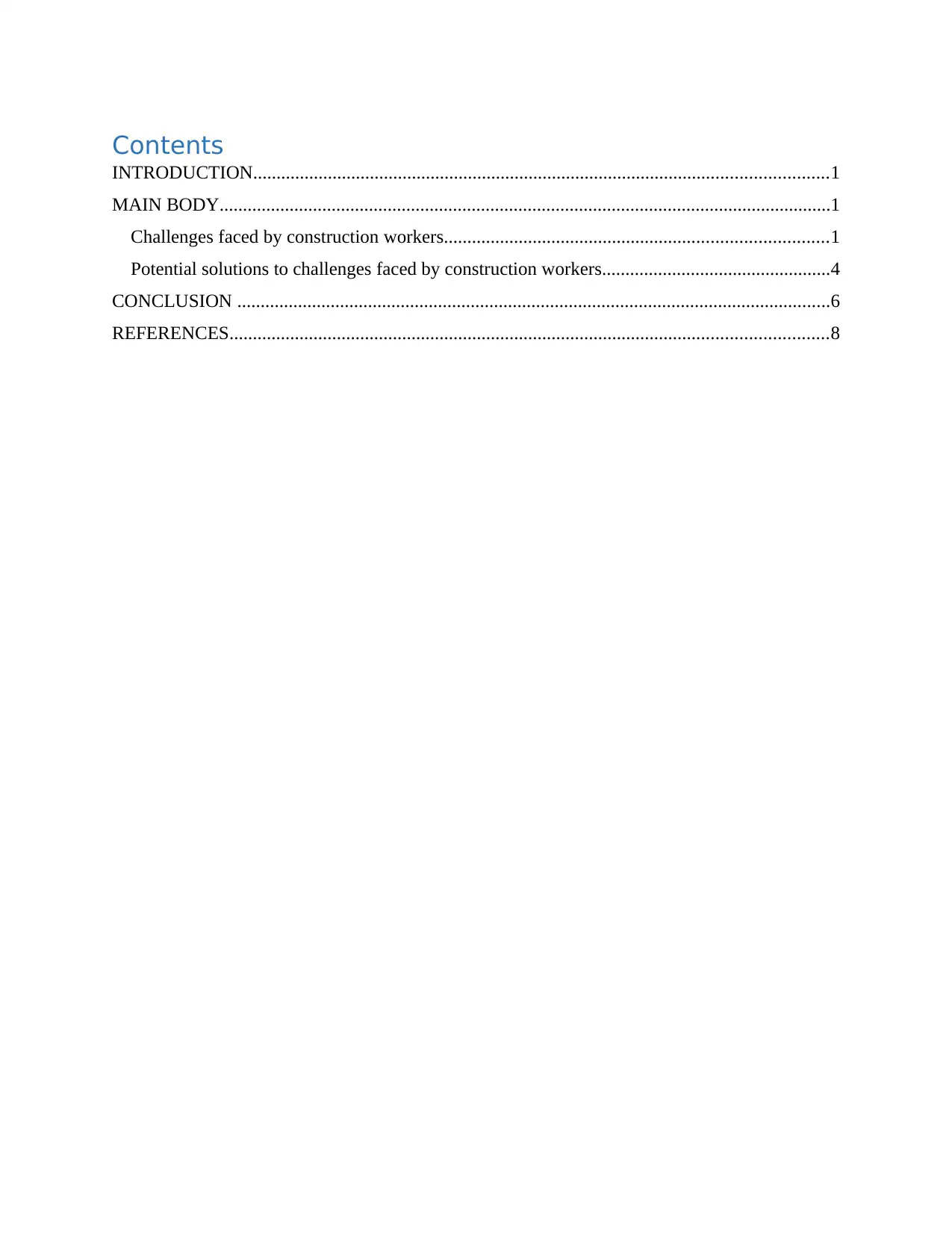
Contents
INTRODUCTION...........................................................................................................................1
MAIN BODY...................................................................................................................................1
Challenges faced by construction workers..................................................................................1
Potential solutions to challenges faced by construction workers.................................................4
CONCLUSION ...............................................................................................................................6
REFERENCES................................................................................................................................8
INTRODUCTION...........................................................................................................................1
MAIN BODY...................................................................................................................................1
Challenges faced by construction workers..................................................................................1
Potential solutions to challenges faced by construction workers.................................................4
CONCLUSION ...............................................................................................................................6
REFERENCES................................................................................................................................8
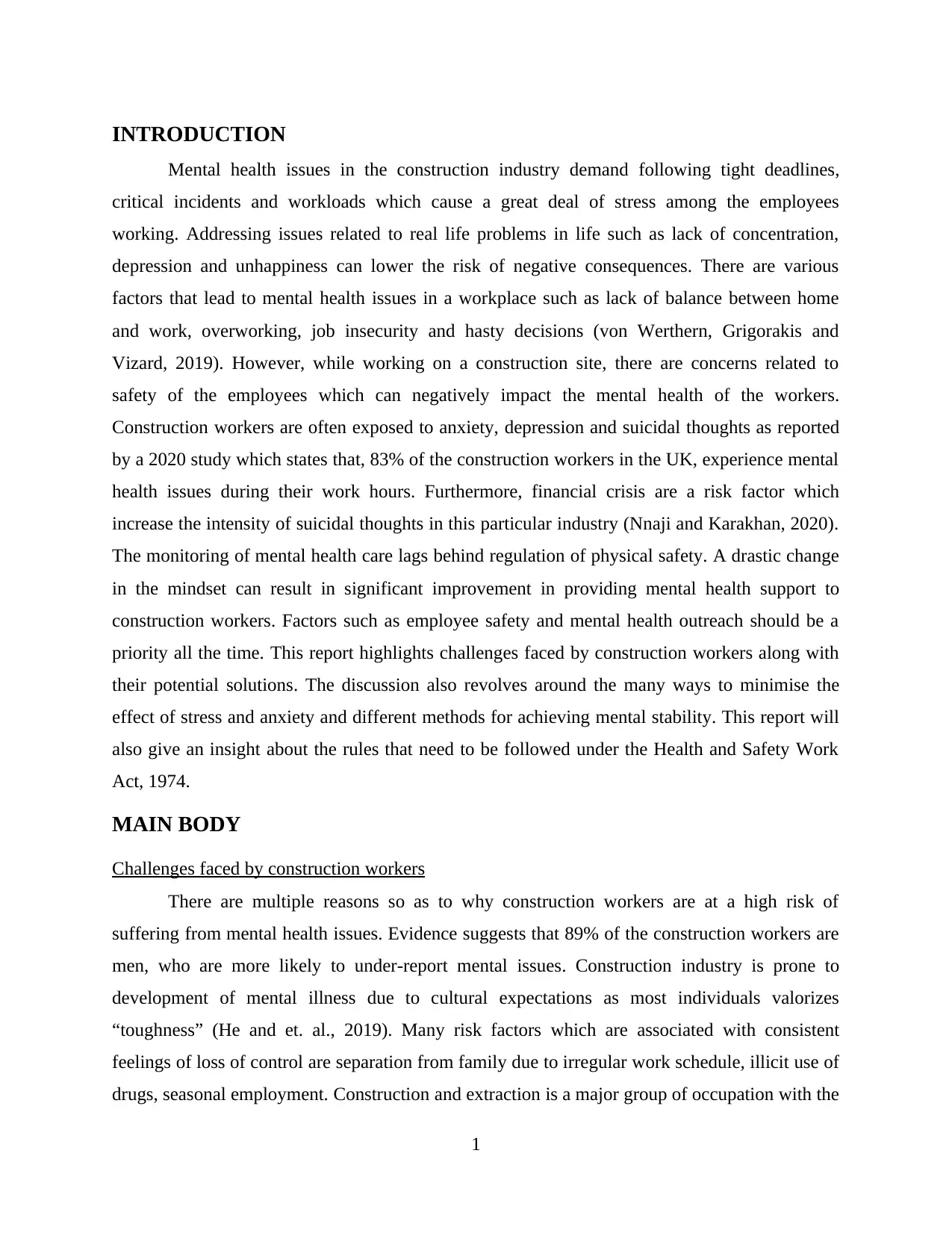
INTRODUCTION
Mental health issues in the construction industry demand following tight deadlines,
critical incidents and workloads which cause a great deal of stress among the employees
working. Addressing issues related to real life problems in life such as lack of concentration,
depression and unhappiness can lower the risk of negative consequences. There are various
factors that lead to mental health issues in a workplace such as lack of balance between home
and work, overworking, job insecurity and hasty decisions (von Werthern, Grigorakis and
Vizard, 2019). However, while working on a construction site, there are concerns related to
safety of the employees which can negatively impact the mental health of the workers.
Construction workers are often exposed to anxiety, depression and suicidal thoughts as reported
by a 2020 study which states that, 83% of the construction workers in the UK, experience mental
health issues during their work hours. Furthermore, financial crisis are a risk factor which
increase the intensity of suicidal thoughts in this particular industry (Nnaji and Karakhan, 2020).
The monitoring of mental health care lags behind regulation of physical safety. A drastic change
in the mindset can result in significant improvement in providing mental health support to
construction workers. Factors such as employee safety and mental health outreach should be a
priority all the time. This report highlights challenges faced by construction workers along with
their potential solutions. The discussion also revolves around the many ways to minimise the
effect of stress and anxiety and different methods for achieving mental stability. This report will
also give an insight about the rules that need to be followed under the Health and Safety Work
Act, 1974.
MAIN BODY
Challenges faced by construction workers
There are multiple reasons so as to why construction workers are at a high risk of
suffering from mental health issues. Evidence suggests that 89% of the construction workers are
men, who are more likely to under-report mental issues. Construction industry is prone to
development of mental illness due to cultural expectations as most individuals valorizes
“toughness” (He and et. al., 2019). Many risk factors which are associated with consistent
feelings of loss of control are separation from family due to irregular work schedule, illicit use of
drugs, seasonal employment. Construction and extraction is a major group of occupation with the
1
Mental health issues in the construction industry demand following tight deadlines,
critical incidents and workloads which cause a great deal of stress among the employees
working. Addressing issues related to real life problems in life such as lack of concentration,
depression and unhappiness can lower the risk of negative consequences. There are various
factors that lead to mental health issues in a workplace such as lack of balance between home
and work, overworking, job insecurity and hasty decisions (von Werthern, Grigorakis and
Vizard, 2019). However, while working on a construction site, there are concerns related to
safety of the employees which can negatively impact the mental health of the workers.
Construction workers are often exposed to anxiety, depression and suicidal thoughts as reported
by a 2020 study which states that, 83% of the construction workers in the UK, experience mental
health issues during their work hours. Furthermore, financial crisis are a risk factor which
increase the intensity of suicidal thoughts in this particular industry (Nnaji and Karakhan, 2020).
The monitoring of mental health care lags behind regulation of physical safety. A drastic change
in the mindset can result in significant improvement in providing mental health support to
construction workers. Factors such as employee safety and mental health outreach should be a
priority all the time. This report highlights challenges faced by construction workers along with
their potential solutions. The discussion also revolves around the many ways to minimise the
effect of stress and anxiety and different methods for achieving mental stability. This report will
also give an insight about the rules that need to be followed under the Health and Safety Work
Act, 1974.
MAIN BODY
Challenges faced by construction workers
There are multiple reasons so as to why construction workers are at a high risk of
suffering from mental health issues. Evidence suggests that 89% of the construction workers are
men, who are more likely to under-report mental issues. Construction industry is prone to
development of mental illness due to cultural expectations as most individuals valorizes
“toughness” (He and et. al., 2019). Many risk factors which are associated with consistent
feelings of loss of control are separation from family due to irregular work schedule, illicit use of
drugs, seasonal employment. Construction and extraction is a major group of occupation with the
1
⊘ This is a preview!⊘
Do you want full access?
Subscribe today to unlock all pages.

Trusted by 1+ million students worldwide
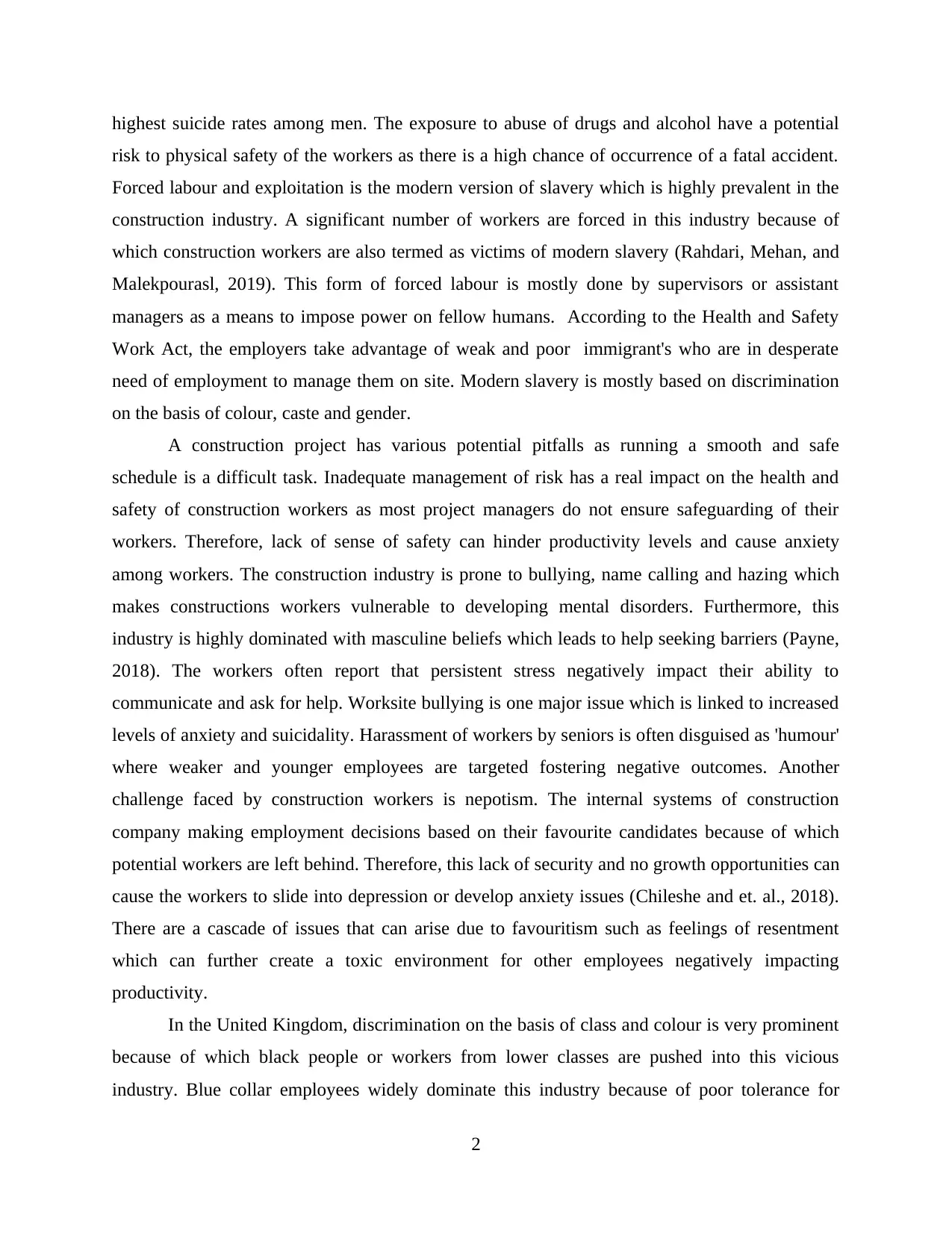
highest suicide rates among men. The exposure to abuse of drugs and alcohol have a potential
risk to physical safety of the workers as there is a high chance of occurrence of a fatal accident.
Forced labour and exploitation is the modern version of slavery which is highly prevalent in the
construction industry. A significant number of workers are forced in this industry because of
which construction workers are also termed as victims of modern slavery (Rahdari, Mehan, and
Malekpourasl, 2019). This form of forced labour is mostly done by supervisors or assistant
managers as a means to impose power on fellow humans. According to the Health and Safety
Work Act, the employers take advantage of weak and poor immigrant's who are in desperate
need of employment to manage them on site. Modern slavery is mostly based on discrimination
on the basis of colour, caste and gender.
A construction project has various potential pitfalls as running a smooth and safe
schedule is a difficult task. Inadequate management of risk has a real impact on the health and
safety of construction workers as most project managers do not ensure safeguarding of their
workers. Therefore, lack of sense of safety can hinder productivity levels and cause anxiety
among workers. The construction industry is prone to bullying, name calling and hazing which
makes constructions workers vulnerable to developing mental disorders. Furthermore, this
industry is highly dominated with masculine beliefs which leads to help seeking barriers (Payne,
2018). The workers often report that persistent stress negatively impact their ability to
communicate and ask for help. Worksite bullying is one major issue which is linked to increased
levels of anxiety and suicidality. Harassment of workers by seniors is often disguised as 'humour'
where weaker and younger employees are targeted fostering negative outcomes. Another
challenge faced by construction workers is nepotism. The internal systems of construction
company making employment decisions based on their favourite candidates because of which
potential workers are left behind. Therefore, this lack of security and no growth opportunities can
cause the workers to slide into depression or develop anxiety issues (Chileshe and et. al., 2018).
There are a cascade of issues that can arise due to favouritism such as feelings of resentment
which can further create a toxic environment for other employees negatively impacting
productivity.
In the United Kingdom, discrimination on the basis of class and colour is very prominent
because of which black people or workers from lower classes are pushed into this vicious
industry. Blue collar employees widely dominate this industry because of poor tolerance for
2
risk to physical safety of the workers as there is a high chance of occurrence of a fatal accident.
Forced labour and exploitation is the modern version of slavery which is highly prevalent in the
construction industry. A significant number of workers are forced in this industry because of
which construction workers are also termed as victims of modern slavery (Rahdari, Mehan, and
Malekpourasl, 2019). This form of forced labour is mostly done by supervisors or assistant
managers as a means to impose power on fellow humans. According to the Health and Safety
Work Act, the employers take advantage of weak and poor immigrant's who are in desperate
need of employment to manage them on site. Modern slavery is mostly based on discrimination
on the basis of colour, caste and gender.
A construction project has various potential pitfalls as running a smooth and safe
schedule is a difficult task. Inadequate management of risk has a real impact on the health and
safety of construction workers as most project managers do not ensure safeguarding of their
workers. Therefore, lack of sense of safety can hinder productivity levels and cause anxiety
among workers. The construction industry is prone to bullying, name calling and hazing which
makes constructions workers vulnerable to developing mental disorders. Furthermore, this
industry is highly dominated with masculine beliefs which leads to help seeking barriers (Payne,
2018). The workers often report that persistent stress negatively impact their ability to
communicate and ask for help. Worksite bullying is one major issue which is linked to increased
levels of anxiety and suicidality. Harassment of workers by seniors is often disguised as 'humour'
where weaker and younger employees are targeted fostering negative outcomes. Another
challenge faced by construction workers is nepotism. The internal systems of construction
company making employment decisions based on their favourite candidates because of which
potential workers are left behind. Therefore, this lack of security and no growth opportunities can
cause the workers to slide into depression or develop anxiety issues (Chileshe and et. al., 2018).
There are a cascade of issues that can arise due to favouritism such as feelings of resentment
which can further create a toxic environment for other employees negatively impacting
productivity.
In the United Kingdom, discrimination on the basis of class and colour is very prominent
because of which black people or workers from lower classes are pushed into this vicious
industry. Blue collar employees widely dominate this industry because of poor tolerance for
2
Paraphrase This Document
Need a fresh take? Get an instant paraphrase of this document with our AI Paraphraser
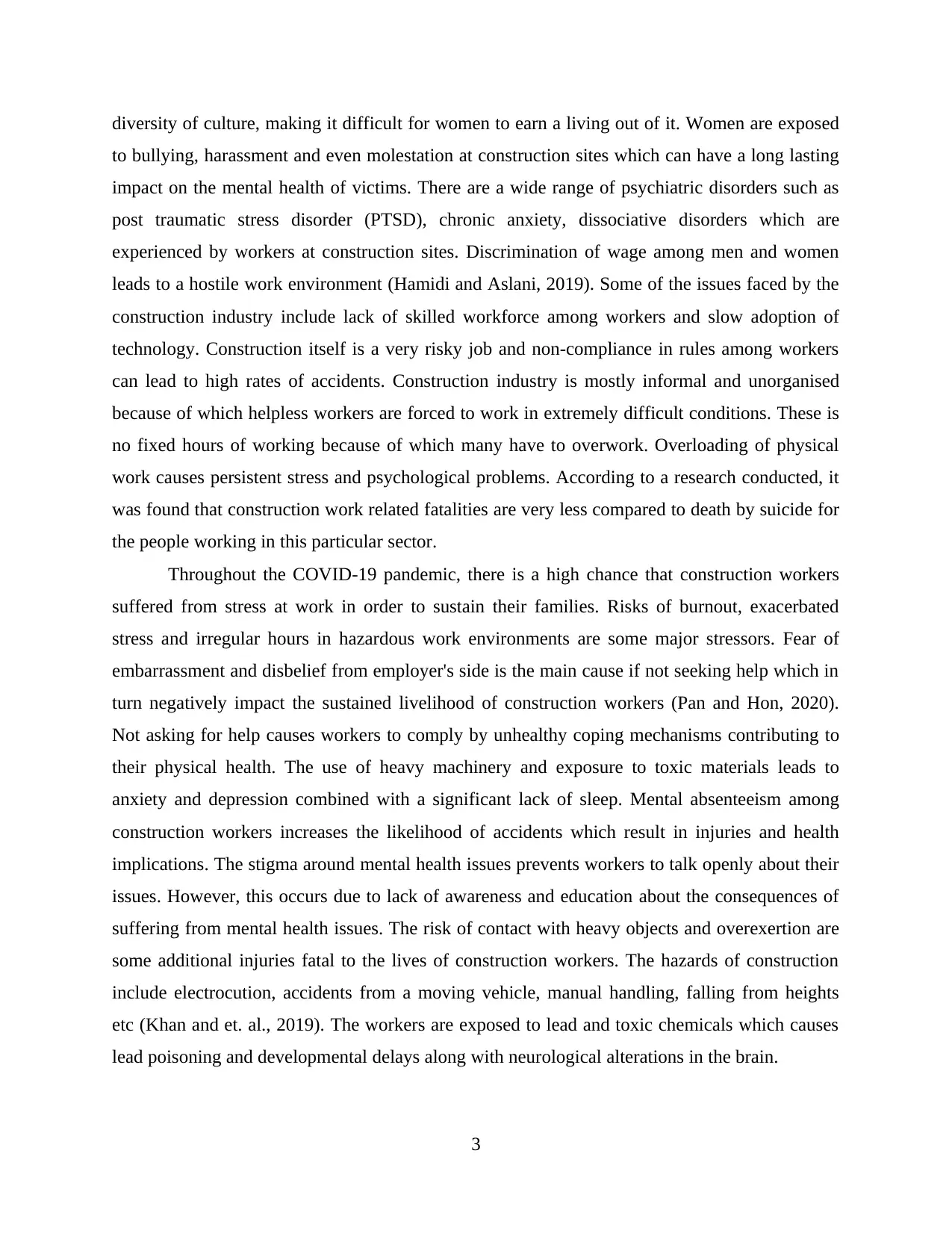
diversity of culture, making it difficult for women to earn a living out of it. Women are exposed
to bullying, harassment and even molestation at construction sites which can have a long lasting
impact on the mental health of victims. There are a wide range of psychiatric disorders such as
post traumatic stress disorder (PTSD), chronic anxiety, dissociative disorders which are
experienced by workers at construction sites. Discrimination of wage among men and women
leads to a hostile work environment (Hamidi and Aslani, 2019). Some of the issues faced by the
construction industry include lack of skilled workforce among workers and slow adoption of
technology. Construction itself is a very risky job and non-compliance in rules among workers
can lead to high rates of accidents. Construction industry is mostly informal and unorganised
because of which helpless workers are forced to work in extremely difficult conditions. These is
no fixed hours of working because of which many have to overwork. Overloading of physical
work causes persistent stress and psychological problems. According to a research conducted, it
was found that construction work related fatalities are very less compared to death by suicide for
the people working in this particular sector.
Throughout the COVID-19 pandemic, there is a high chance that construction workers
suffered from stress at work in order to sustain their families. Risks of burnout, exacerbated
stress and irregular hours in hazardous work environments are some major stressors. Fear of
embarrassment and disbelief from employer's side is the main cause if not seeking help which in
turn negatively impact the sustained livelihood of construction workers (Pan and Hon, 2020).
Not asking for help causes workers to comply by unhealthy coping mechanisms contributing to
their physical health. The use of heavy machinery and exposure to toxic materials leads to
anxiety and depression combined with a significant lack of sleep. Mental absenteeism among
construction workers increases the likelihood of accidents which result in injuries and health
implications. The stigma around mental health issues prevents workers to talk openly about their
issues. However, this occurs due to lack of awareness and education about the consequences of
suffering from mental health issues. The risk of contact with heavy objects and overexertion are
some additional injuries fatal to the lives of construction workers. The hazards of construction
include electrocution, accidents from a moving vehicle, manual handling, falling from heights
etc (Khan and et. al., 2019). The workers are exposed to lead and toxic chemicals which causes
lead poisoning and developmental delays along with neurological alterations in the brain.
3
to bullying, harassment and even molestation at construction sites which can have a long lasting
impact on the mental health of victims. There are a wide range of psychiatric disorders such as
post traumatic stress disorder (PTSD), chronic anxiety, dissociative disorders which are
experienced by workers at construction sites. Discrimination of wage among men and women
leads to a hostile work environment (Hamidi and Aslani, 2019). Some of the issues faced by the
construction industry include lack of skilled workforce among workers and slow adoption of
technology. Construction itself is a very risky job and non-compliance in rules among workers
can lead to high rates of accidents. Construction industry is mostly informal and unorganised
because of which helpless workers are forced to work in extremely difficult conditions. These is
no fixed hours of working because of which many have to overwork. Overloading of physical
work causes persistent stress and psychological problems. According to a research conducted, it
was found that construction work related fatalities are very less compared to death by suicide for
the people working in this particular sector.
Throughout the COVID-19 pandemic, there is a high chance that construction workers
suffered from stress at work in order to sustain their families. Risks of burnout, exacerbated
stress and irregular hours in hazardous work environments are some major stressors. Fear of
embarrassment and disbelief from employer's side is the main cause if not seeking help which in
turn negatively impact the sustained livelihood of construction workers (Pan and Hon, 2020).
Not asking for help causes workers to comply by unhealthy coping mechanisms contributing to
their physical health. The use of heavy machinery and exposure to toxic materials leads to
anxiety and depression combined with a significant lack of sleep. Mental absenteeism among
construction workers increases the likelihood of accidents which result in injuries and health
implications. The stigma around mental health issues prevents workers to talk openly about their
issues. However, this occurs due to lack of awareness and education about the consequences of
suffering from mental health issues. The risk of contact with heavy objects and overexertion are
some additional injuries fatal to the lives of construction workers. The hazards of construction
include electrocution, accidents from a moving vehicle, manual handling, falling from heights
etc (Khan and et. al., 2019). The workers are exposed to lead and toxic chemicals which causes
lead poisoning and developmental delays along with neurological alterations in the brain.
3
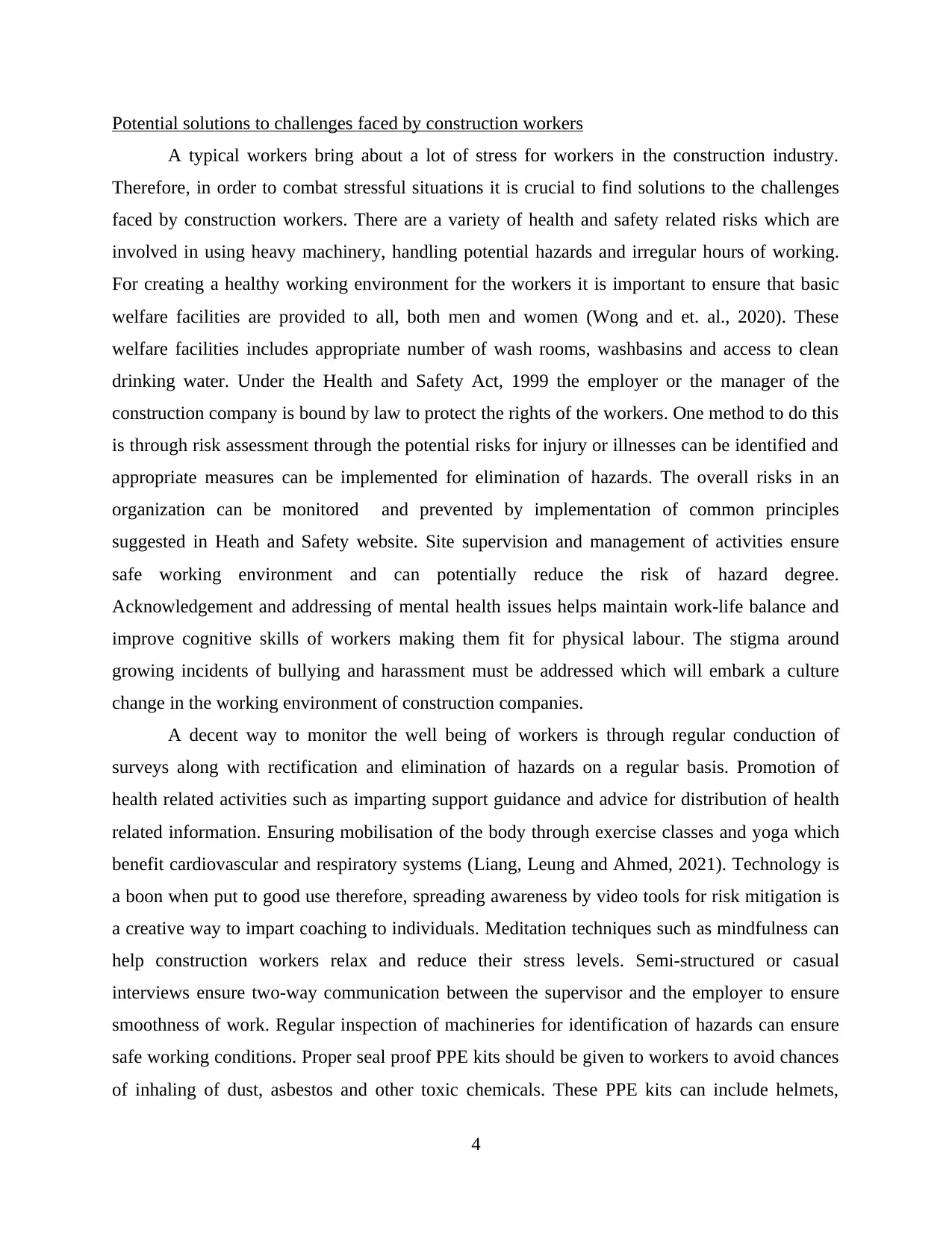
Potential solutions to challenges faced by construction workers
A typical workers bring about a lot of stress for workers in the construction industry.
Therefore, in order to combat stressful situations it is crucial to find solutions to the challenges
faced by construction workers. There are a variety of health and safety related risks which are
involved in using heavy machinery, handling potential hazards and irregular hours of working.
For creating a healthy working environment for the workers it is important to ensure that basic
welfare facilities are provided to all, both men and women (Wong and et. al., 2020). These
welfare facilities includes appropriate number of wash rooms, washbasins and access to clean
drinking water. Under the Health and Safety Act, 1999 the employer or the manager of the
construction company is bound by law to protect the rights of the workers. One method to do this
is through risk assessment through the potential risks for injury or illnesses can be identified and
appropriate measures can be implemented for elimination of hazards. The overall risks in an
organization can be monitored and prevented by implementation of common principles
suggested in Heath and Safety website. Site supervision and management of activities ensure
safe working environment and can potentially reduce the risk of hazard degree.
Acknowledgement and addressing of mental health issues helps maintain work-life balance and
improve cognitive skills of workers making them fit for physical labour. The stigma around
growing incidents of bullying and harassment must be addressed which will embark a culture
change in the working environment of construction companies.
A decent way to monitor the well being of workers is through regular conduction of
surveys along with rectification and elimination of hazards on a regular basis. Promotion of
health related activities such as imparting support guidance and advice for distribution of health
related information. Ensuring mobilisation of the body through exercise classes and yoga which
benefit cardiovascular and respiratory systems (Liang, Leung and Ahmed, 2021). Technology is
a boon when put to good use therefore, spreading awareness by video tools for risk mitigation is
a creative way to impart coaching to individuals. Meditation techniques such as mindfulness can
help construction workers relax and reduce their stress levels. Semi-structured or casual
interviews ensure two-way communication between the supervisor and the employer to ensure
smoothness of work. Regular inspection of machineries for identification of hazards can ensure
safe working conditions. Proper seal proof PPE kits should be given to workers to avoid chances
of inhaling of dust, asbestos and other toxic chemicals. These PPE kits can include helmets,
4
A typical workers bring about a lot of stress for workers in the construction industry.
Therefore, in order to combat stressful situations it is crucial to find solutions to the challenges
faced by construction workers. There are a variety of health and safety related risks which are
involved in using heavy machinery, handling potential hazards and irregular hours of working.
For creating a healthy working environment for the workers it is important to ensure that basic
welfare facilities are provided to all, both men and women (Wong and et. al., 2020). These
welfare facilities includes appropriate number of wash rooms, washbasins and access to clean
drinking water. Under the Health and Safety Act, 1999 the employer or the manager of the
construction company is bound by law to protect the rights of the workers. One method to do this
is through risk assessment through the potential risks for injury or illnesses can be identified and
appropriate measures can be implemented for elimination of hazards. The overall risks in an
organization can be monitored and prevented by implementation of common principles
suggested in Heath and Safety website. Site supervision and management of activities ensure
safe working environment and can potentially reduce the risk of hazard degree.
Acknowledgement and addressing of mental health issues helps maintain work-life balance and
improve cognitive skills of workers making them fit for physical labour. The stigma around
growing incidents of bullying and harassment must be addressed which will embark a culture
change in the working environment of construction companies.
A decent way to monitor the well being of workers is through regular conduction of
surveys along with rectification and elimination of hazards on a regular basis. Promotion of
health related activities such as imparting support guidance and advice for distribution of health
related information. Ensuring mobilisation of the body through exercise classes and yoga which
benefit cardiovascular and respiratory systems (Liang, Leung and Ahmed, 2021). Technology is
a boon when put to good use therefore, spreading awareness by video tools for risk mitigation is
a creative way to impart coaching to individuals. Meditation techniques such as mindfulness can
help construction workers relax and reduce their stress levels. Semi-structured or casual
interviews ensure two-way communication between the supervisor and the employer to ensure
smoothness of work. Regular inspection of machineries for identification of hazards can ensure
safe working conditions. Proper seal proof PPE kits should be given to workers to avoid chances
of inhaling of dust, asbestos and other toxic chemicals. These PPE kits can include helmets,
4
⊘ This is a preview!⊘
Do you want full access?
Subscribe today to unlock all pages.

Trusted by 1+ million students worldwide
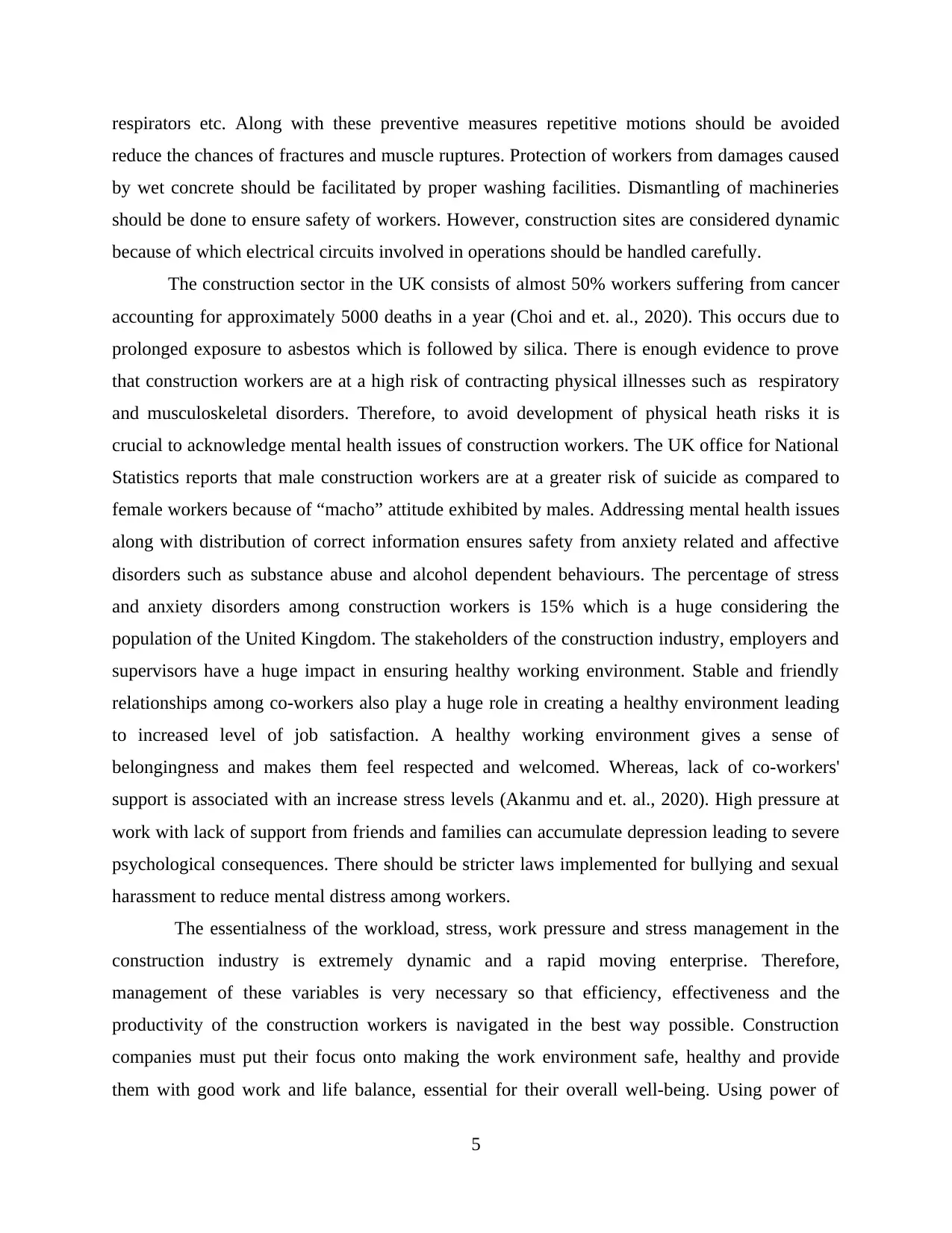
respirators etc. Along with these preventive measures repetitive motions should be avoided
reduce the chances of fractures and muscle ruptures. Protection of workers from damages caused
by wet concrete should be facilitated by proper washing facilities. Dismantling of machineries
should be done to ensure safety of workers. However, construction sites are considered dynamic
because of which electrical circuits involved in operations should be handled carefully.
The construction sector in the UK consists of almost 50% workers suffering from cancer
accounting for approximately 5000 deaths in a year (Choi and et. al., 2020). This occurs due to
prolonged exposure to asbestos which is followed by silica. There is enough evidence to prove
that construction workers are at a high risk of contracting physical illnesses such as respiratory
and musculoskeletal disorders. Therefore, to avoid development of physical heath risks it is
crucial to acknowledge mental health issues of construction workers. The UK office for National
Statistics reports that male construction workers are at a greater risk of suicide as compared to
female workers because of “macho” attitude exhibited by males. Addressing mental health issues
along with distribution of correct information ensures safety from anxiety related and affective
disorders such as substance abuse and alcohol dependent behaviours. The percentage of stress
and anxiety disorders among construction workers is 15% which is a huge considering the
population of the United Kingdom. The stakeholders of the construction industry, employers and
supervisors have a huge impact in ensuring healthy working environment. Stable and friendly
relationships among co-workers also play a huge role in creating a healthy environment leading
to increased level of job satisfaction. A healthy working environment gives a sense of
belongingness and makes them feel respected and welcomed. Whereas, lack of co-workers'
support is associated with an increase stress levels (Akanmu and et. al., 2020). High pressure at
work with lack of support from friends and families can accumulate depression leading to severe
psychological consequences. There should be stricter laws implemented for bullying and sexual
harassment to reduce mental distress among workers.
The essentialness of the workload, stress, work pressure and stress management in the
construction industry is extremely dynamic and a rapid moving enterprise. Therefore,
management of these variables is very necessary so that efficiency, effectiveness and the
productivity of the construction workers is navigated in the best way possible. Construction
companies must put their focus onto making the work environment safe, healthy and provide
them with good work and life balance, essential for their overall well-being. Using power of
5
reduce the chances of fractures and muscle ruptures. Protection of workers from damages caused
by wet concrete should be facilitated by proper washing facilities. Dismantling of machineries
should be done to ensure safety of workers. However, construction sites are considered dynamic
because of which electrical circuits involved in operations should be handled carefully.
The construction sector in the UK consists of almost 50% workers suffering from cancer
accounting for approximately 5000 deaths in a year (Choi and et. al., 2020). This occurs due to
prolonged exposure to asbestos which is followed by silica. There is enough evidence to prove
that construction workers are at a high risk of contracting physical illnesses such as respiratory
and musculoskeletal disorders. Therefore, to avoid development of physical heath risks it is
crucial to acknowledge mental health issues of construction workers. The UK office for National
Statistics reports that male construction workers are at a greater risk of suicide as compared to
female workers because of “macho” attitude exhibited by males. Addressing mental health issues
along with distribution of correct information ensures safety from anxiety related and affective
disorders such as substance abuse and alcohol dependent behaviours. The percentage of stress
and anxiety disorders among construction workers is 15% which is a huge considering the
population of the United Kingdom. The stakeholders of the construction industry, employers and
supervisors have a huge impact in ensuring healthy working environment. Stable and friendly
relationships among co-workers also play a huge role in creating a healthy environment leading
to increased level of job satisfaction. A healthy working environment gives a sense of
belongingness and makes them feel respected and welcomed. Whereas, lack of co-workers'
support is associated with an increase stress levels (Akanmu and et. al., 2020). High pressure at
work with lack of support from friends and families can accumulate depression leading to severe
psychological consequences. There should be stricter laws implemented for bullying and sexual
harassment to reduce mental distress among workers.
The essentialness of the workload, stress, work pressure and stress management in the
construction industry is extremely dynamic and a rapid moving enterprise. Therefore,
management of these variables is very necessary so that efficiency, effectiveness and the
productivity of the construction workers is navigated in the best way possible. Construction
companies must put their focus onto making the work environment safe, healthy and provide
them with good work and life balance, essential for their overall well-being. Using power of
5
Paraphrase This Document
Need a fresh take? Get an instant paraphrase of this document with our AI Paraphraser
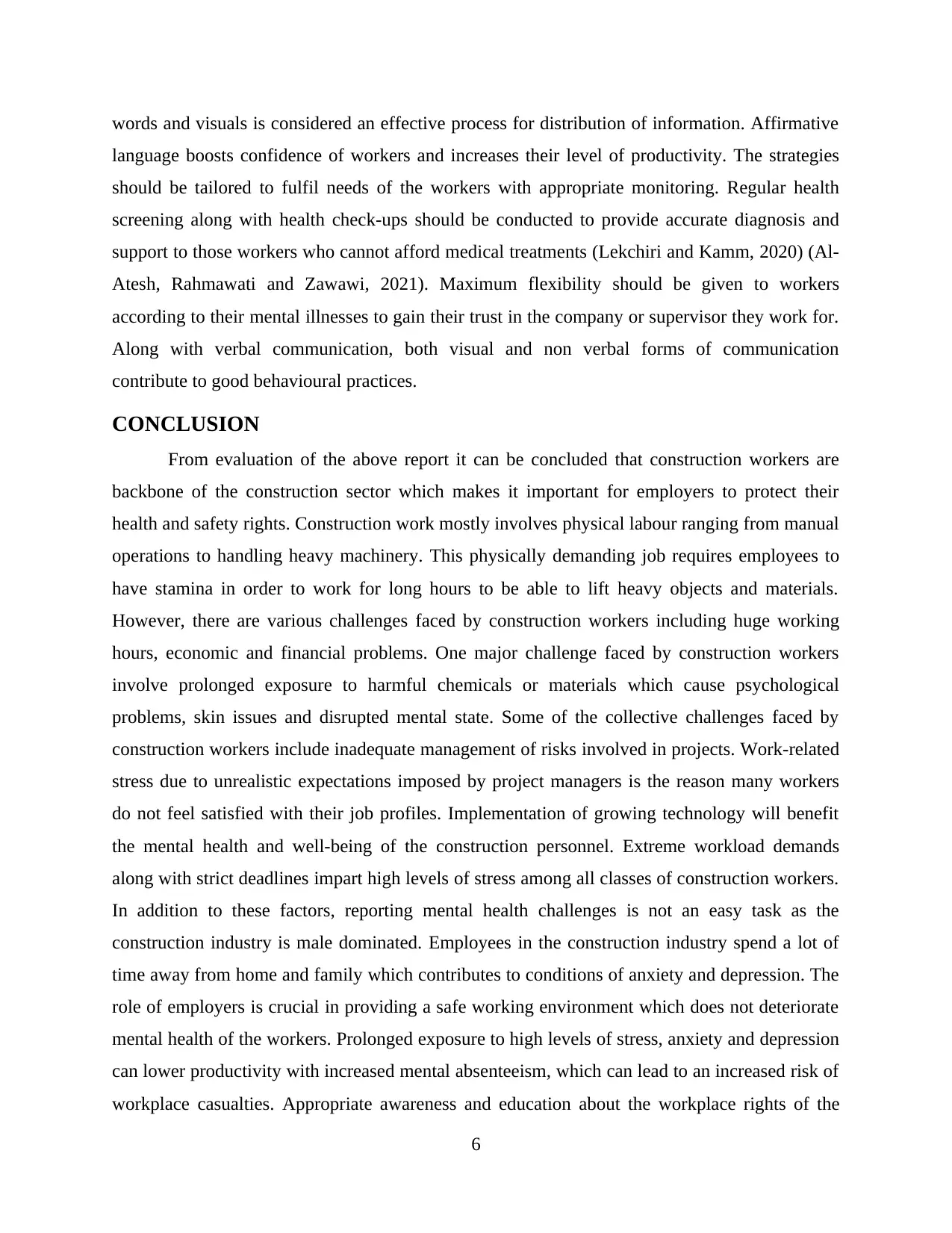
words and visuals is considered an effective process for distribution of information. Affirmative
language boosts confidence of workers and increases their level of productivity. The strategies
should be tailored to fulfil needs of the workers with appropriate monitoring. Regular health
screening along with health check-ups should be conducted to provide accurate diagnosis and
support to those workers who cannot afford medical treatments (Lekchiri and Kamm, 2020) (Al-
Atesh, Rahmawati and Zawawi, 2021). Maximum flexibility should be given to workers
according to their mental illnesses to gain their trust in the company or supervisor they work for.
Along with verbal communication, both visual and non verbal forms of communication
contribute to good behavioural practices.
CONCLUSION
From evaluation of the above report it can be concluded that construction workers are
backbone of the construction sector which makes it important for employers to protect their
health and safety rights. Construction work mostly involves physical labour ranging from manual
operations to handling heavy machinery. This physically demanding job requires employees to
have stamina in order to work for long hours to be able to lift heavy objects and materials.
However, there are various challenges faced by construction workers including huge working
hours, economic and financial problems. One major challenge faced by construction workers
involve prolonged exposure to harmful chemicals or materials which cause psychological
problems, skin issues and disrupted mental state. Some of the collective challenges faced by
construction workers include inadequate management of risks involved in projects. Work-related
stress due to unrealistic expectations imposed by project managers is the reason many workers
do not feel satisfied with their job profiles. Implementation of growing technology will benefit
the mental health and well-being of the construction personnel. Extreme workload demands
along with strict deadlines impart high levels of stress among all classes of construction workers.
In addition to these factors, reporting mental health challenges is not an easy task as the
construction industry is male dominated. Employees in the construction industry spend a lot of
time away from home and family which contributes to conditions of anxiety and depression. The
role of employers is crucial in providing a safe working environment which does not deteriorate
mental health of the workers. Prolonged exposure to high levels of stress, anxiety and depression
can lower productivity with increased mental absenteeism, which can lead to an increased risk of
workplace casualties. Appropriate awareness and education about the workplace rights of the
6
language boosts confidence of workers and increases their level of productivity. The strategies
should be tailored to fulfil needs of the workers with appropriate monitoring. Regular health
screening along with health check-ups should be conducted to provide accurate diagnosis and
support to those workers who cannot afford medical treatments (Lekchiri and Kamm, 2020) (Al-
Atesh, Rahmawati and Zawawi, 2021). Maximum flexibility should be given to workers
according to their mental illnesses to gain their trust in the company or supervisor they work for.
Along with verbal communication, both visual and non verbal forms of communication
contribute to good behavioural practices.
CONCLUSION
From evaluation of the above report it can be concluded that construction workers are
backbone of the construction sector which makes it important for employers to protect their
health and safety rights. Construction work mostly involves physical labour ranging from manual
operations to handling heavy machinery. This physically demanding job requires employees to
have stamina in order to work for long hours to be able to lift heavy objects and materials.
However, there are various challenges faced by construction workers including huge working
hours, economic and financial problems. One major challenge faced by construction workers
involve prolonged exposure to harmful chemicals or materials which cause psychological
problems, skin issues and disrupted mental state. Some of the collective challenges faced by
construction workers include inadequate management of risks involved in projects. Work-related
stress due to unrealistic expectations imposed by project managers is the reason many workers
do not feel satisfied with their job profiles. Implementation of growing technology will benefit
the mental health and well-being of the construction personnel. Extreme workload demands
along with strict deadlines impart high levels of stress among all classes of construction workers.
In addition to these factors, reporting mental health challenges is not an easy task as the
construction industry is male dominated. Employees in the construction industry spend a lot of
time away from home and family which contributes to conditions of anxiety and depression. The
role of employers is crucial in providing a safe working environment which does not deteriorate
mental health of the workers. Prolonged exposure to high levels of stress, anxiety and depression
can lower productivity with increased mental absenteeism, which can lead to an increased risk of
workplace casualties. Appropriate awareness and education about the workplace rights of the
6
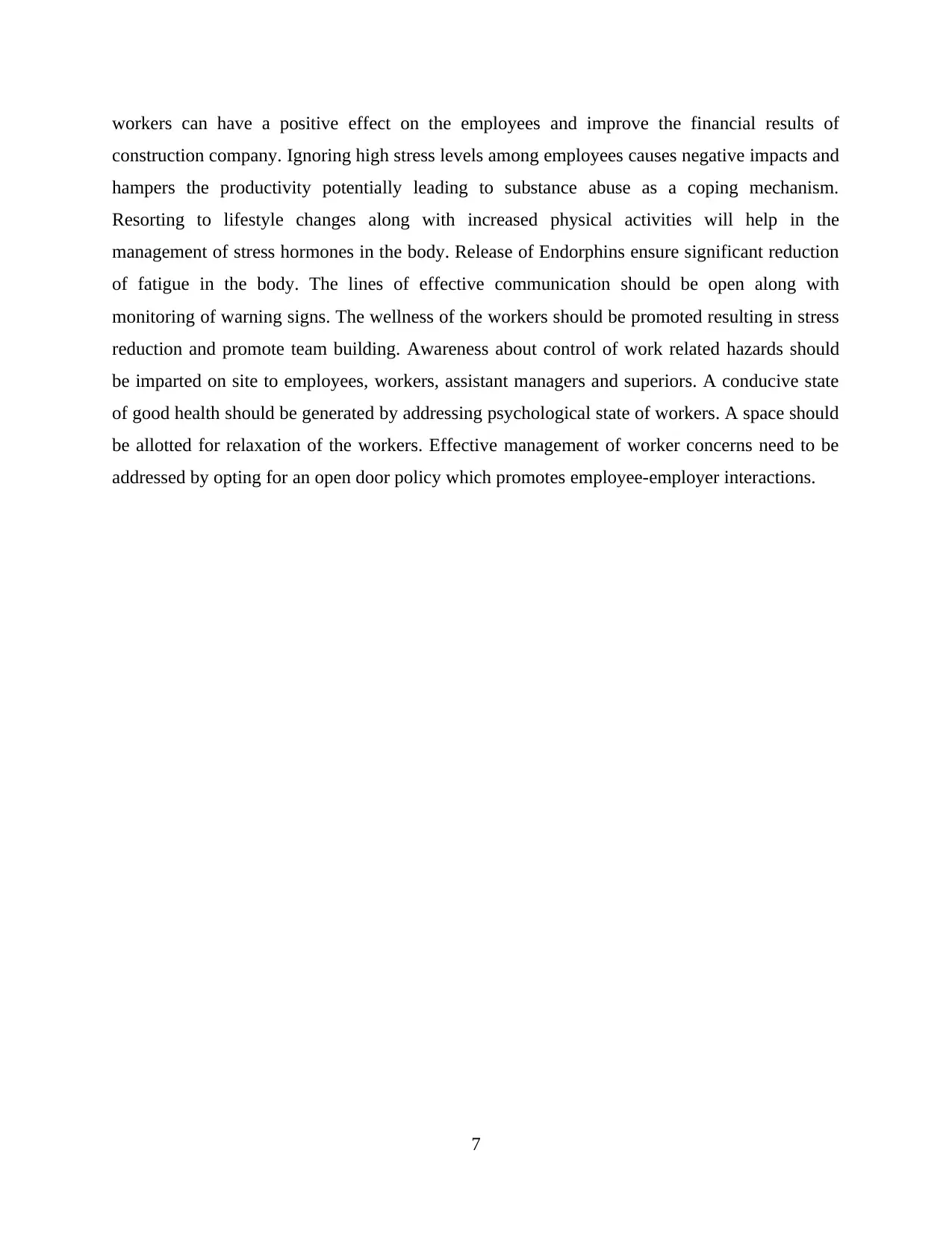
workers can have a positive effect on the employees and improve the financial results of
construction company. Ignoring high stress levels among employees causes negative impacts and
hampers the productivity potentially leading to substance abuse as a coping mechanism.
Resorting to lifestyle changes along with increased physical activities will help in the
management of stress hormones in the body. Release of Endorphins ensure significant reduction
of fatigue in the body. The lines of effective communication should be open along with
monitoring of warning signs. The wellness of the workers should be promoted resulting in stress
reduction and promote team building. Awareness about control of work related hazards should
be imparted on site to employees, workers, assistant managers and superiors. A conducive state
of good health should be generated by addressing psychological state of workers. A space should
be allotted for relaxation of the workers. Effective management of worker concerns need to be
addressed by opting for an open door policy which promotes employee-employer interactions.
7
construction company. Ignoring high stress levels among employees causes negative impacts and
hampers the productivity potentially leading to substance abuse as a coping mechanism.
Resorting to lifestyle changes along with increased physical activities will help in the
management of stress hormones in the body. Release of Endorphins ensure significant reduction
of fatigue in the body. The lines of effective communication should be open along with
monitoring of warning signs. The wellness of the workers should be promoted resulting in stress
reduction and promote team building. Awareness about control of work related hazards should
be imparted on site to employees, workers, assistant managers and superiors. A conducive state
of good health should be generated by addressing psychological state of workers. A space should
be allotted for relaxation of the workers. Effective management of worker concerns need to be
addressed by opting for an open door policy which promotes employee-employer interactions.
7
⊘ This is a preview!⊘
Do you want full access?
Subscribe today to unlock all pages.

Trusted by 1+ million students worldwide

REFERENCES
Books and Journals:
Wong, T.K.M., Man, S.S. and Chan, A.H.S., 2020. Critical factors for the use or non-use of
personal protective equipment amongst construction workers. Safety science, 126,
p.104663.
Liang, Q., Leung, M.Y. and Ahmed, K., 2021. How adoption of coping behaviors determines
construction workers’ safety: A quantitative and qualitative investigation. Safety
Science, 133, p.105035.
Choi, J., Gu, B., Chin, S. and Lee, J.S., 2020. Machine learning predictive model based on
national data for fatal accidents of construction workers. Automation in Construction, 110,
p.102974.
Akanmu, A.A., Olayiwola, J., Ogunseiju, O. and McFeeters, D., 2020. Cyber-physical postural
training system for construction workers. Automation in construction, 117, p.103272.
Lekchiri, S. and Kamm, J.D., 2020. Navigating barriers faced by women in leadership positions
in the US construction industry: a retrospective on women’s continued struggle in a male-
dominated industry. European Journal of Training and Development, 44(6/7), pp.575-594.
Al-Atesh, E., Rahmawati, Y. and Zawawi, N.A.W.A., 2021, June. Sustainability criteria for
green building material selection in the malaysian construction industry. In Proceedings of
the International Conference on Civil, Offshore and Environmental Engineering (pp. 693-
700). Springer, Singapore.
Pan, W. and Hon, C.K., 2020, June. Briefing: Modular integrated construction for high-rise
buildings. In Proceedings of the Institution of Civil Engineers-Municipal Engineer (Vol.
173, No. 2, pp. 64-68). Thomas Telford Ltd.
Hamidi, F. and Aslani, F., 2019. Additive manufacturing of cementitious composites: Materials,
methods, potentials, and challenges. Construction and Building Materials, 218, pp.582-
609.
Chileshe, N., Rameezdeen, R., Hosseini, M.R., Martek, I., Li, H.X. and Panjehbashi-Aghdam, P.,
2018. Factors driving the implementation of reverse logistics: A quantified model for the
construction industry. Waste management, 79, pp.48-57.
Rahdari, A., Mehan, A. and Malekpourasl, B., 2019. Sustainable real estate in the Middle East:
Challenges and future trends. In Sustainable Real Estate (pp. 403-426). Palgrave
Macmillan, Cham.
He, C., Jia, G., McCabe, B., Chen, Y. and Sun, J., 2019. Impact of psychological capital on
construction worker safety behavior: Communication competence as a mediator. Journal of
safety research, 71, pp.231-241.
Nnaji, C. and Karakhan, A.A., 2020. Technologies for safety and health management in
construction: Current use, implementation benefits and limitations, and adoption
barriers. Journal of Building Engineering, 29, p.101212.
Payne, M., 2018. Social construction in social work and social action. In Constructing social
work practices (pp. 25-66). Routledge.
Khan, M.W., Ali, Y., De Felice, F. and Petrillo, A., 2019. Occupational health and safety in
construction industry in Pakistan using modified-SIRA method. Safety science, 118,
pp.109-118.
von Werthern, M., Grigorakis, G. and Vizard, E., 2019. The mental health and wellbeing of
Unaccompanied Refugee Minors (URMs). Child abuse & neglect, 98, p.104146.
8
Books and Journals:
Wong, T.K.M., Man, S.S. and Chan, A.H.S., 2020. Critical factors for the use or non-use of
personal protective equipment amongst construction workers. Safety science, 126,
p.104663.
Liang, Q., Leung, M.Y. and Ahmed, K., 2021. How adoption of coping behaviors determines
construction workers’ safety: A quantitative and qualitative investigation. Safety
Science, 133, p.105035.
Choi, J., Gu, B., Chin, S. and Lee, J.S., 2020. Machine learning predictive model based on
national data for fatal accidents of construction workers. Automation in Construction, 110,
p.102974.
Akanmu, A.A., Olayiwola, J., Ogunseiju, O. and McFeeters, D., 2020. Cyber-physical postural
training system for construction workers. Automation in construction, 117, p.103272.
Lekchiri, S. and Kamm, J.D., 2020. Navigating barriers faced by women in leadership positions
in the US construction industry: a retrospective on women’s continued struggle in a male-
dominated industry. European Journal of Training and Development, 44(6/7), pp.575-594.
Al-Atesh, E., Rahmawati, Y. and Zawawi, N.A.W.A., 2021, June. Sustainability criteria for
green building material selection in the malaysian construction industry. In Proceedings of
the International Conference on Civil, Offshore and Environmental Engineering (pp. 693-
700). Springer, Singapore.
Pan, W. and Hon, C.K., 2020, June. Briefing: Modular integrated construction for high-rise
buildings. In Proceedings of the Institution of Civil Engineers-Municipal Engineer (Vol.
173, No. 2, pp. 64-68). Thomas Telford Ltd.
Hamidi, F. and Aslani, F., 2019. Additive manufacturing of cementitious composites: Materials,
methods, potentials, and challenges. Construction and Building Materials, 218, pp.582-
609.
Chileshe, N., Rameezdeen, R., Hosseini, M.R., Martek, I., Li, H.X. and Panjehbashi-Aghdam, P.,
2018. Factors driving the implementation of reverse logistics: A quantified model for the
construction industry. Waste management, 79, pp.48-57.
Rahdari, A., Mehan, A. and Malekpourasl, B., 2019. Sustainable real estate in the Middle East:
Challenges and future trends. In Sustainable Real Estate (pp. 403-426). Palgrave
Macmillan, Cham.
He, C., Jia, G., McCabe, B., Chen, Y. and Sun, J., 2019. Impact of psychological capital on
construction worker safety behavior: Communication competence as a mediator. Journal of
safety research, 71, pp.231-241.
Nnaji, C. and Karakhan, A.A., 2020. Technologies for safety and health management in
construction: Current use, implementation benefits and limitations, and adoption
barriers. Journal of Building Engineering, 29, p.101212.
Payne, M., 2018. Social construction in social work and social action. In Constructing social
work practices (pp. 25-66). Routledge.
Khan, M.W., Ali, Y., De Felice, F. and Petrillo, A., 2019. Occupational health and safety in
construction industry in Pakistan using modified-SIRA method. Safety science, 118,
pp.109-118.
von Werthern, M., Grigorakis, G. and Vizard, E., 2019. The mental health and wellbeing of
Unaccompanied Refugee Minors (URMs). Child abuse & neglect, 98, p.104146.
8
1 out of 10
Related Documents
Your All-in-One AI-Powered Toolkit for Academic Success.
+13062052269
info@desklib.com
Available 24*7 on WhatsApp / Email
![[object Object]](/_next/static/media/star-bottom.7253800d.svg)
Unlock your academic potential
Copyright © 2020–2025 A2Z Services. All Rights Reserved. Developed and managed by ZUCOL.





